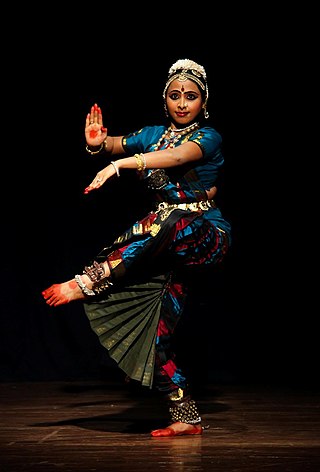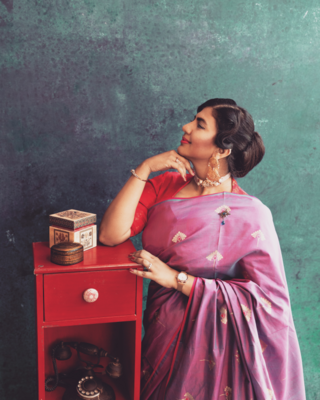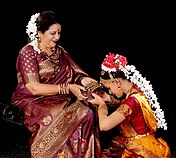
Bharatanatyam [Tamil: பரதநாட்டியம் ]is an Indian classical dance form that originated in Tamil Nadu, India. It is a classical dance form recognized by the Sangeet Natak Akademi, and expresses South Indian religious themes and spiritual ideas of Hinduism and Jainism.

Indian classical dance, or Shastriya Nritya, is an umbrella term for different regionally-specific Indian classical dance traditions, rooted in predominantly Hindu musical theatre performance, the theory and practice of which can be traced to the Sanskrit text Natya Shastra. The number of Indian classical dance styles ranges from six to eight to twelve, or more, depending on the source and scholar; the main organisation for Indian arts preservation, the Sangeet Natak Academy recognizes eight: Bharatanatyam, Kathak, Kuchipudi, Odissi, Kathakali, Sattriya, Manipuri and Mohiniyattam. Additionally, the Indian Ministry of Culture includes Chhau in its list, recognising nine total styles. Scholars such as Drid Williams add Chhau, Yakshagana and Bhagavata Mela to the list. Each dance tradition originates and comes from a different state and/or region of India; for example, Bharatanatyam is from Tamil Nadu in the south of India, Odissi is from the east coast state of Odisha, and Manipuri is from the northeastern state of Manipur. The music associated with these different dance performances consists many compositions in Hindi, Malayalam, Meitei (Manipuri), Sanskrit, Tamil, Odia, Telugu, Assamese, and many other Indian-Subcontinent languages; they represent a unity of core ideas and a diversity of styles, costumes, and expression.

Dance in India comprises numerous styles of dances, generally classified as classical or folk. As with other aspects of Indian culture, different forms of dances originated in different parts of India, developed according to the local traditions and also imbibed elements from other parts of the country.

The culture of Chennai, popularly called the "Gateway to the South India", is distinct from that of any other Indian city. Chennai continues to be traditional and conventional in certain ways. Traditional music, dance and all other art forms of Tamil Nadu are very popular in the city. One can find a peculiar cultural blend in city, from traditional foods to fast foods, from ancient temple architecture to modern high-rises, and from classical music and dance to the growing nightlife.

Swarnamalya Ganesh is an Indian dancer, Professor, Actress, and TV anchor. She received the award "Yuvakala Bharat" at the age of 17. Her first major role in television was on the Sun TV show Ilamai Pudhumai and then went on to do a number of films in the Tamil language.
Neila Sathyalingam was a Singaporean classical Indian dancer, choreographer and instructor of Sri Lankan Tamil origin. An alumna of Kalakshetra in Madras under the tutelage of Srimathi Rukmini Devi Arundale, she emigrated with her family to Singapore in 1974. In 1977 she and her husband founded the performance arts company Apsaras Arts, which has staged performances throughout the world. She was the company's artistic director and continued to teach dance.
Various dance forms are practiced in Tamil Nadu, the southernmost state of India. Tamil Nadu is the home of the Tamil people, who speak Tamil language, one of the oldest surviving languages in India. With archaeological evidence pointing to the Tamilakam region being inhabited for more than 3,800 years, Tamil culture has seen multiple influences over the years and has developed diversely. With its diverse culture, many forms of individual and group dances have their origins in the region.

Chitra Visweswaran is an Indian Bharata Natyam dancer who runs a dance school, the Chidambaram Academy of Performing Arts, in Chennai.
Urmila Sathyanarayana is an Indian classical dancer of bharatanatyam.

Smitha Rajan is an Indian Mohiniyattam performer from Kerala and granddaughter of the Indian classical dancers Padma Shri Kalamandalam Krishnan Nair and Kalamandalam Kalyanikutty Amma.
Alarmel Valli is an Indian classical dancer and Bharatanatyam-Pandanallur choreographer.

Joyce Kakariyil Paul is a Bharatanatyam dancer, exercise physiologist, and anthropologist from India. Classically trained in Bharatanatyam from Kalakshetra, she is known for her technical acumen, rigour, and precision. Paul had her initial dance training under Padmashri Leela Samson and further training under Prof C.V. Chandrasekhar and Janardhanan Sir among others. She has trained in Mohiniattam, the classical dance of Kerala. In 2003, she founded Arpan Performing Arts, an organization dedicated to promoting the folk and classical traditions of India, where she currently serves as its creative director.

Kalanidhi Narayanan was an Indian dancer and teacher of Indian classical dance form of Bharatnatyam, who was the early non-devadasi girl to learn the dance form and perform it on stage in the 1930s and 1940s. After a brief career in the 1940s, she returned to dance in 1973 and became a notable teacher of abhinaya.
Rathi is an Indian former actress, who appeared mostly in Tamil cinema and Telugu cinema.

Savitha Sastry is an Indian dancer and choreographer best known as an exponent of Bharatanatyam. She is known to experiment with the format of traditional Bharatanatyam by using the techniques of Bharatanatyam to showcase theme-based productions based on novel stories, not based on Indian mythology or religion. Her innovations have been described as 'path breaking' by critics. and she is considered to be a 'renaissance architect' who 'holds the distinction of being the dancer to have brought out a revolution in the way Bharatanatyam is presented after Rukmini Devi Arundale'.

Murugashankari Leo is an Indian dance tutor, theatric actor, and research scholar.

Rekha Raju is an Indian classical dance performer and teacher from Bangalore, Karnataka. She specialises in the Bharatnatyam and Mohiniyattam dance forms.
Meenakshi Chitharanjan, an Indian classical dancer, teacher and choreographer, is known as an exponent of the Pandanallur style of the classical dance form of Bharatanatyam. She is the founder of Kaladiksha, an institution promoting Bharatanatyam and striving to preserve the Pandanallur tradition. A disciple of the father-son duo of Chokkalingam Pillai and Subbaraya Pillai, she is a recipient of several honours including Kalaimamani Award of the Government of Tamil Nadu and the Natya Kala Sarathi of Sri Parthasarathy Swami Sabha. The Government of India awarded her the fourth highest civilian honour of the Padma Shri, in 2008, for her contributions to classical dance.
R Muthukannammal is a seventh generation veteran Sadir dancer from the Indian State of Tamil Nadu. She is the only surviving person among the 32 Devadasis who served the deity at the Viralimalai Murugan temple and she is the last woman to have the ceremony pottukkattutal of dedicating oneself to God performed at the Viralimalai temple. In the year 2022, Govt of India honoured Muthukannammal by conferring the Padma Shri award for her contributions in the field of art. The dance form Sadir, variously called as Sadiraattam or Parathaiyar Aattam or Thevarattam, is a classical Indian dance from which was reinvented, modified and rechristened as Bharatanatyam through the efforts of E Krishna Iyer in 1932. However, Muthukannammal has chosen to call her art form Sadir, making her the only Sadir exponent today.











